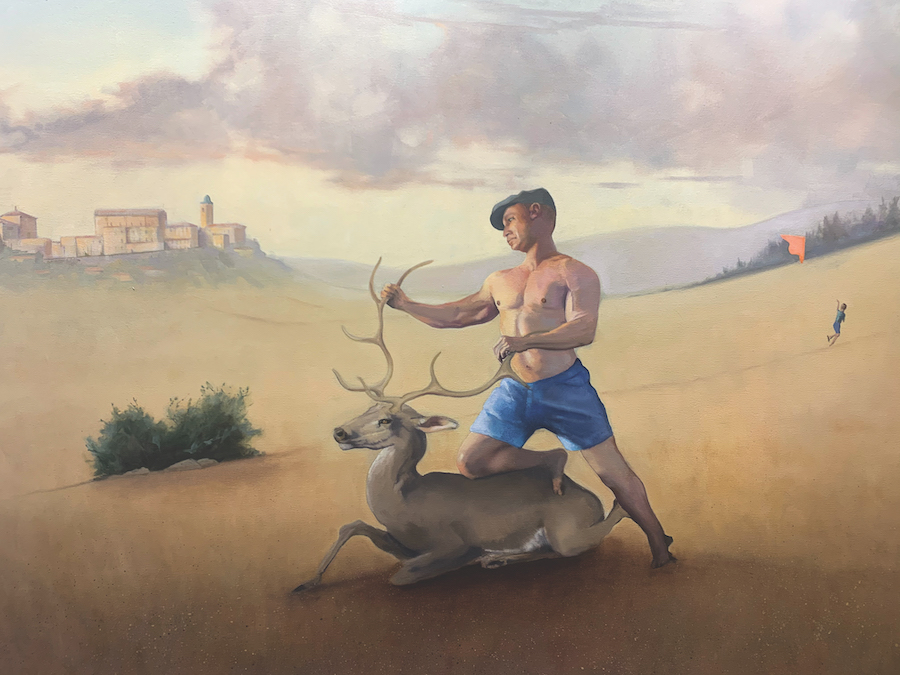“I am constantly drawn back to the figure,” says Ray Wiggs. “There are many subjects that I enjoy painting. However, the figure has always been alluring to me, because no other subject of focus has such soul.”
Throughout Wiggs’s long career as an artist and a gallerist — his Ray Wiggs Gallery is in Provincetown’s East End — the male figure has often featured prominently in his paintings and in works by artists he represents.

“What is interesting about the male figure,” he says, “is people’s perception of it. Unlike the female figure, the male figure is still considered shocking to some. I don’t quite understand why. I would think that people would have advanced past that. I’m surprised at how many galleries are afraid to carry the male nude. But I understand, because male figurative work is harder to sell, even to gay men.”

The reservations buyers have, Wiggs says, are not whether they like a particular piece or not, but what friends and family will think. “I remember a painting I did of a male figure lying back. I had a gallerist say to me that no gallery would ever accept that painting,” Wiggs says. “I didn’t understand why, because I thought it was a beautiful painting and that there was nothing shameful about it at all. And that painting did sell.”
Contemplating this year’s stark gay pride month during the coronavirus pandemic, Wiggs says he is proud to be of the generation that has seen so many advances for the LGBTQ community. “I never dreamed that I would be legally married to a man one day,” he says. “Pride is significant to me, and I hope it means something to the younger generation, which may not realize how much my generation and others before me have struggled.”
Wiggs grew up in in Palm Beach, Fla., in a Southern Baptist household with a twin brother and older brother. “I was constantly compared to them, and I struggled with my sexuality,” he says. “It was very, very difficult for me. I have come to a place of peace, and I am very happy with who I am. I am truly proud of my sexuality.”
When he is painting the male figure, Wiggs does not specifically intend for it to be sensual or even erotic, though that is often how it will be perceived by others. “I’m not thinking about my audience. I’m painting something that I feel is beautiful, and I want to share that.”

Growing up, Wiggs knew that he wanted formal, classical training in art and chose to study in Italy. He went to the Brera Academy in Milan, then relocated to Umbria, studying at the Accademia di Belle Arti di Perugia. “Italy proved to be the perfect setting for me,” he says, “as I was surrounded by so many great art heroes of mine.”
After school, he spent two years living and painting in Italy and returned to the U.S. mainly because of health issues. “I’ve been through a lot,” he says. “I had a seizure once and went through a car windshield. It took me a year to recover, and I lost everything through that accident.”
He says he never intended on having a gallery. “At first, I started selling my work out of the back of a van. Then this man wanted me to host an opening in his office. I did, and the show sold out,” Wiggs recalls. “Someone said, ‘You should have a gallery of your own.’ And I thought, well, why not? So, I got the backing and had a gallery in Palm Beach for years.”
Wiggs eventually relocated to Atlanta, before moving his home and gallery to Provincetown six years ago, where he says he is very happy. “Art is a challenging business,” he says. “However, it is simply in my DNA.”
Wiggs’s devotion to the artists he represents is evident. In conversation, he repeatedly draws attention from his own work to that of others. “I look very hard for my artists,” Wiggs says. “I look at well over a thousand a year, maybe, to get one that I love.”
Once he has chosen someone, Wiggs spends time getting to know not only their work but also the person behind the art. “In the winter, I have a lot of time to visit with my artists,” he says. “And I spend a lot of time with them when they come up here. They usually stay at my house, and I have the chance to get to know them and discuss the work with them. The more I understand about them and their work, the better I am at representing them.”
Wiggs does his own painting during the off-season and dedicates the summer almost entirely to his gallery. “I’m there by myself, because I know from past experience that nobody is more invested in this gallery than I am.”
He is determined to be optimistic about the coming season, though he knows that “it is a sink-or-swim sort of situation,” he says. “I have a lot of contacts and a nice clientele that has followed me for years, so I’ll be fine. But I think we’ll see a lot of galleries go under this year.”
Wiggs hopes that buyers will see this as a good time to buy art. “Whenever there is a downturn in the economy, galleries are eager to sell and artists are hungry. So, I encourage the public to take advantage of that opportunity.”



